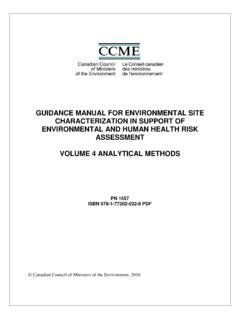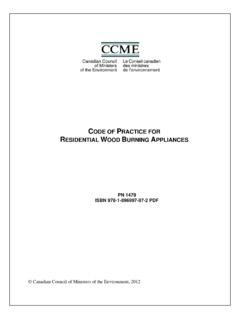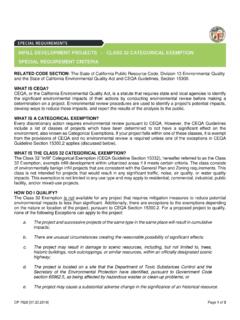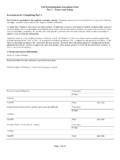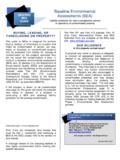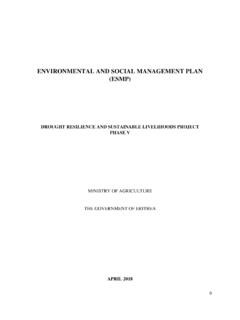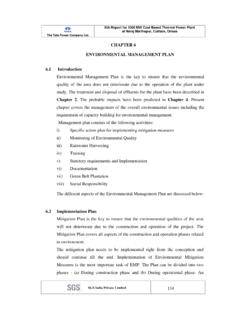Transcription of Guidance Manual for Environmental Site Characterization in ...
1 Guidance Manual FOR Environmental site Characterization IN SUPPORT OF Environmental AND HUMAN HEALTH RISK assessment VOLUME 1 Guidance Manual PN 1551 ISBN 978-1-77202-026-7 PDF Canadian Council of Ministers of the Environment, 2016 Volume 1: Guidance Manual i PREFACE This Manual is one of a series of volumes dedicated to providing Guidance on Environmental site Characterization in support of Environmental and human health risk assessment at contaminated sites. Canadian Council of Ministers of the Environment (CCME) initiated the National Contaminated Sites Remediation Program (NCSRP), a five year program (1989-1995), to develop a consistent national approach for the assessment and remediation of Canada s contaminated sites, and specifically to clean up high-risk orphan contaminated sites.
2 As part of providing national tools for site Characterization , the NCSRP released the Guidance Manual on Sampling, Analysis, and Data Management for Contaminated Sites (Volume I: Main Report, and Volume II: Analytical Method Summaries) in 1993, and the Subsurface assessment Handbook for Contaminated Sites in 1994. The purpose of this document, and related volumes, is to provide a replacement of the 1993 sampling and analytical Guidance . This work is being done by the Soil Quality Guidelines Task Group, which was established by CCME to develop Canadian Soil Quality Guidelines and to continue providing national Guidance on contaminated sites after sunsetting of the NCSRP. The goal of the Environmental site Characterization Guidance is to provide Canadians with a consistent approach to sampling and analyzing complex Environmental matrices, such that the data obtained will be representative and of known quality.
3 The Guidance provides a summary of key elements that should be performed, and reported, during site investigations. The Guidance also recommends sample handling and storage requirements, analytical methods, and method specific quality control and assurance procedures to ensure that the results of laboratory analyses are reported for Canadian Environmental Quality Guidelines with sufficient quality upon which to base decisions. The Environmental site Characterization Guidance consists of four volumes: Volume 1: Guidance Manual [this document] Volume 2: Checklists Volume 3: Suggested Operating Procedures Volume 4: Analytical Methods Methods and any reference to specific sampling equipment provided in this Guidance are provided for information purposes only.
4 CCME does not warrant the use of any of these methods or equipment. The responsibility for selection and use lies solely with the user. Volume 1: Guidance Manual ii ACKNOWLEDGEMENTS The primary authors of the four volume site Characterization Guidance were: Dr. Ian Hers, Mr. Guy Patrick, Dr. Reidar Zapf-Gilje (Golder Associates Ltd) for volume 1 (chapters 1-8), volume 2, and volume 3, and SOPs 1-6; Ms. Miranda Henning, Ms. Andrea Fogg, Ms. Katrina Leigh (Environ International Corp.) for volume 1 (chapters 9-11) and sections of chapter 4, media specific material in volume 2, volume 3, and SOPs 7-17; Barry Loescher, with the assistance of Elizabeth Walsh, (Maxxam Analytics) volume 4. Golder, Environ and Maxxam provided assistance in addressing public review comments.
5 The four volumes were extensively reviewed by members of the CCME Soil Quality Guidelines Task Group, and colleagues within their respective jurisdictions. CCME would like to thank reviewers who provided feedback during the public review process. The contribution of time and expertise of all participants is gratefully acknowledged. Volume 1: Guidance Manual iii TABLE OF CONTENTS 1 INTRODUCTION .. 1 Background and Purpose .. 1 Intended Audience and Guidance Application .. 1 Scope .. 1 Guidance Outline .. 2 CONTAMINATED site INVESTIGATION AND MANAGEMENT PROCESS .. 6 Integrated Risk Management Process for Contaminated Sites .. 6 site Characterization Process .. 6 Phased Investigation Approach .. 7 Data Quality as a Central Theme to the site Characterization Process.
6 7 Development of a Conceptual site Model .. 8 Define the Project Background and Goals .. 12 Establish the Investigation Objectives .. 13 Prepare a Sampling and Analysis Plan .. 14 Review of Existing Data .. 14 Pre-mobilization Tasks .. 14 Sampling Media, Data Types and Investigation Tools .. 15 Sampling Rationale and Design .. 16 Sampling and Analysis Methods and Quality Assurance Project Plan .. 18 Conduct the Field Investigation Program Conventional Phased and Expedited site assessment Process .. 19 Validate and Interpret Data .. 21 Resources and Weblinks .. 23 References .. 23 QUALITY ASSURANCE/QUALITY CONTROL .. 25 Quality Assurance Project Plan .. 25 Data Quality Indicators .. 27 Quality Control .. 28 Quality Control Checks and Samples .. 28 Recommended Minimum Frequency of Quality Control Samples.
7 29 Data Quality Targets .. 29 Duplicate Samples .. 30 Reporting of QA/QC .. 31 References .. 31 CONCEPTUAL site MODEL FOR CONTAMINATED 32 Contamination Sources and Types .. 33 1: Guidance Manual iv Overview .. 33 Common Types of Contamination .. 33 Non-Point Sources of Contamination .. 34 Emergent or Less Common Chemicals .. 37 Conceptual site Model for LNAPL and DNAPL Characterization .. 37 Conceptual site Model for Groundwater Characterization .. 39 Partitioning .. 40 Unsaturated Zone Chemical Transport .. 41 Groundwater Contaminant Transport .. 42 Considerations for Fractured Bedrock .. 44 Considerations for Permafrost .. 45 Conceptual site Model for Soil Characterization .. 45 Conceptual site Model for Soil Vapour .. 49 Contamination Sources.
8 50 Chemical Transfer to Vapour Phase (Volatilization) .. 51 Vadose Zone Fate and Transport Processes .. 53 Near-Building Processes for Soil Vapour Intrusion .. 55 Summary .. 55 Conceptual site Scenarios for Vapour Intrusion .. 56 Resources, References and Links .. 64 Conceptual site Model for Surface Water Characterization .. 64 Study Area and Reference Area Identification .. 66 Conceptual site Model for Sediment Characterization .. 68 Conceptual site Model for Biological Characterization .. 71 References .. 73 SOIL Characterization Guidance .. 76 Context, Purpose and Scope .. 76 Conceptual site Model for Soil Characterization .. 77 Soil Sampling Design .. 78 Representative Sampling Challenges .. 79 Sampling Design Strategies .. 81 Statistical Methods for Sampling Design.
9 85 Discrete and Composite Samples .. 88 Investigation Soil Sampling Methods .. 89 Field Analytical Methods .. 92 Headspace Vapour Tests .. 93 Colourimetric Tests .. 94 Immunoassay Tests .. 94 X-ray fluorescence (XRF) .. 96 Field Preservation of Soil Samples for VOC Analysis .. 97 Methods for Data Interpretation .. 98 1: Guidance Manual v Statistical Data Analysis for Soil Characterization .. 99 Non-Detect Values .. 101 Statistical Approach to Characterizing Contaminated Soil .. 101 Data Presentation and Reporting .. 102 Resources and Weblinks .. 102 References .. 104 GROUNDWATER Characterization Guidance .. 110 Purpose, Background and Need .. 110 Obtaining Representative Samples from the Well .. 111 Non-Aqueous Phase Liquids (NAPLs) .. 115 Conceptual site Models for Groundwater Characterization .
10 115 Approach and Sampling Design .. 116 Intrusive Field Program for Groundwater Characterization .. 117 Addressing the Issue of Scale .. 118 Acquiring Groundwater Quality Information .. 119 Available Technologies .. 120 Direct-Push Technologies for Groundwater Characterization .. 122 Acquiring Hydrogeologic Information .. 125 Groundwater Flow Direction .. 125 Groundwater Velocity .. 126 Monitoring and Monitoring Networks .. 128 Well Screen Length and Well Completion Intervals .. 128 Horizontal Spacing of Data Points .. 131 Vertical Spacing of Data Points .. 134 Field and Laboratory Data Acquisition .. 134 Well Development .. 135 Well Purging and Sampling .. 135 Field Laboratories .. 138 Special Considerations .. 138 Selection of Analytical Tests .. 140 Data Validation and Quality Assurance/Quality Control.
